#d1e2dd Color Information
In a RGB color space, hex #d1e2dd is composed of 82% red, 88.6% green and 86.7% blue. Whereas in a CMYK color space, it is composed of 7.5% cyan, 0% magenta, 2.2% yellow and 11.4% black. It has a hue angle of 162.4 degrees, a saturation of 22.7% and a lightness of 85.3%. #d1e2dd color hex could be obtained by blending #ffffff with #a3c5bb. Closest websafe color is: #cccccc.
-
- R 82
- G 89
- B 87
-
- C 8
- M 0
- Y 2
- K 11
● #d1e2dd color description : Light grayish cyan - lime green.
#d1e2dd Color Conversion
The hexadecimal color #d1e2dd has RGB values of R:209, G:226, B:221 and CMYK values of C:0.08, M:0, Y:0.02, K:0.11. Its decimal value is 13755101.
| Hex triplet | d1e2dd | #d1e2dd |
|---|---|---|
| RGB Decimal | 209, 226, 221 | rgb(209,226,221) |
| RGB Percent | 82, 88.6, 86.7 | rgb(82%,88.6%,86.7%) |
| CMYK | 8, 0, 2, 11 | |
| HSL | 162.4°, 22.7, 85.3 | hsl(162.4,22.7%,85.3%) |
| HSV (or HSB) | 162.4°, 7.5, 88.6 | |
| Web Safe | cccccc | #cccccc |
| CIE-LAB | 88.528, -6.584, 0.49 |
|---|---|
| XYZ | 66.539, 73.168, 79.02 |
| xyY | 0.304, 0.335, 73.168 |
| CIE-LCH | 88.528, 6.602, 175.748 |
| CIE-LUV | 88.528, -9.068, 1.903 |
| Hunter-Lab | 85.538, -10.838, 5.105 |
| Binary | 11010001, 11100010, 11011101 |
Color Schemes with #d1e2dd
Alternatives to #d1e2dd
Below, you can see some colors close to #d1e2dd. Having a set of related colors can be useful if you need an inspirational alternative to your original color choice.
#d1e2dd Preview
This text has a font color of #d1e2dd.
<span style="color:#d1e2dd;">Text here</span>This paragraph has a background color of #d1e2dd.
<p style="background-color:#d1e2dd;">Content here</p>This element has a border color of #d1e2dd.
<div style="border:1px solid #d1e2dd;">Content here</div>.text {color:#d1e2dd;}.background {background-color:#d1e2dd;}.border {border:1px solid #d1e2dd;}Shades and Tints of #d1e2dd
A shade is achieved by adding black to any pure hue, while a tint is created by mixing white to any pure color. In this example, #010202 is the darkest color, while #f5f9f8 is the lightest one.
-
#010202
#010202rgb(1,2,2) -
#090e0d
#090e0drgb(9,14,13) -
#111a17
#111a17rgb(17,26,23) -
#182622
#182622rgb(24,38,34) -
#20322d
#20322drgb(32,50,45) -
#273e38
#273e38rgb(39,62,56) -
#2f4a42
#2f4a42rgb(47,74,66) -
#36564d
#36564drgb(54,86,77) -
#3e6258
#3e6258rgb(62,98,88) -
#466e62
#466e62rgb(70,110,98) -
#4d7a6d
#4d7a6drgb(77,122,109) -
#558678
#558678rgb(85,134,120) -
#5c9283
#5c9283rgb(92,146,131)
-
#659e8d
#659e8drgb(101,158,141) -
#71a596
#71a596rgb(113,165,150) -
#7dad9f
#7dad9frgb(125,173,159) -
#89b4a8
#89b4a8rgb(137,180,168) -
#95bcb1
#95bcb1rgb(149,188,177) -
#a1c4b9
#a1c4b9rgb(161,196,185) -
#adcbc2
#adcbc2rgb(173,203,194) -
#b9d3cb
#b9d3cbrgb(185,211,203) -
#c5dad4
#c5dad4rgb(197,218,212) -
#d1e2dd
#d1e2ddrgb(209,226,221) -
#ddeae6
#ddeae6rgb(221,234,230) -
#e9f1ef
#e9f1efrgb(233,241,239) -
#f5f9f8
#f5f9f8rgb(245,249,248)
Tones of #d1e2dd
A tone is produced by adding gray to any pure hue. In this case, #d7dcdb is the less saturated color, while #b4ffe9 is the most saturated one.
-
#d7dcdb
#d7dcdbrgb(215,220,219) -
#d4dfdc
#d4dfdcrgb(212,223,220) -
#d1e2dd
#d1e2ddrgb(209,226,221) -
#cee5de
#cee5dergb(206,229,222) -
#cbe8df
#cbe8dfrgb(203,232,223) -
#c8ebe1
#c8ebe1rgb(200,235,225) -
#c5eee2
#c5eee2rgb(197,238,226) -
#c3f0e3
#c3f0e3rgb(195,240,227) -
#c0f3e4
#c0f3e4rgb(192,243,228) -
#bdf6e5
#bdf6e5rgb(189,246,229) -
#baf9e7
#baf9e7rgb(186,249,231) -
#b7fce8
#b7fce8rgb(183,252,232) -
#b4ffe9
#b4ffe9rgb(180,255,233)
Color Blindness Simulator
Below, you can see how #d1e2dd is perceived by people affected by a color vision deficiency. This can be useful if you need to ensure your color combinations are accessible to color-blind users.
